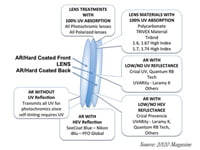You are sitting at your desk, looking at your computer monitor and realize that your eyes are sore; you have a headache and find it hard to focus on the letters and numbers you are reading. You play with the brightness setting on the monitor, increase the font size, but to no avail. Nothing helps.
Medically speaking, this is known as Computer Vision Syndrome or digital eye strain. It is brought on by spending long hours working under artificial fluorescent lights, looking at a display which emits Ultra Violet and Blue Violet light at a close distance and you have unconsciously stopped blinking which causes your eyes to dry out, leading to soreness. By staring at the screen without readjusting your vision distance you are also hypnotizing yourself which blurs your vision.
The latest threat to your vision has been the introduction of new flat screen televisions and monitors using Light Emitting Diode (LED) technology and the latest Organic Light Emitting Diode (OLED) technology with curved screen. These TVs and monitors give off greater amount of High Energy Visible (HEV) or blue-violet light, exposure to which causes retinal damage to your eyes. These devices emit a higher level of blue wavelength light which is one of the reasons why these screens look whiter, brighter and crispier.
Blue light is visible light, which radiates at a short wavelength placing it at one end of the visible light spectrum with a range of approximately 380-500 nanometers. Blue-violet light (380-455 nm) is very close in wavelength to ultraviolet light (100-380 nm), a well-known hazard to our eyes and our health if we are exposed to it in repeated, large doses.
We are born with clear crystalline lenses in our eyes. As we grow old this lens yellows and tends to filter out some of the blue light naturally. This yellowing minimizes the harmful effects and allows you to properly process the benefits of blue light such as wakefulness, heightened attention levels, and increase of melatonin production. However, those who had cataracts surgery and had a clear lens installed are at higher risk to continued retinal damage. These two groups are highly susceptible to eye damage and upset their sleep cycle from blue light when using electronic devices such as Smartphones, tablets, or watching large television screens.
So what can we do to fix this?
Unfortunately screen protector films sold today that claim to eliminate blue light are not quite worth the investment. They only cut down up to 32% of blue light emission coming from the display and also reduce the clarity and color balance.
There are a number of simple, easy solutions that can immediately help to reduce the effects of blue light and ultra-violet light damage.
- Place a NuShield screen protector film over your electronic devices to eliminate the ultra-violet light emission from your device. All NuShield films filter out 99.9% of UV-B rays.
- Download (Just Get Flux) that will allow you to adjust the amount of blue that you see on your computer device. You can set the amount of blue to a comfortable level that can help eliminate headaches.
- You can purchase a melanin pigmented polarized lens to cut down on blue light exposure outside. The NuShield DayVue film allows to you read your display outdoors while wearing these glasses while other films or the bare screen turns dark.
- Limit the number of hours of electronic device use, especially with young children and try to keep the device at least 12 inches from your eyes.
- To help you sleep, try turning off your devices an hour before going to bed and have a standard flat screen TV in the bedroom that has reduced blue light emission.
- If you have a choice, go with LCD or Plasma screen technology instead of the LED technology. The screen might not be as vivid in color, but you will also reduce your chances of getting headaches looking at the screen.
- If possible, do not use LED based lights in your office or home which emit a high concentration of blue wavelength light. The new energy-efficient incandescent bulbs work better and are safer.
- Special glasses with anti-blue light treated lenses can be worn inside when working on devices or watching LED or OLED television screens.

If you have to have cataract surgery, there are lenses available that will filter out the blue light to a degree to reduce retinal damage. There are currently 10 different optical companies that have developed lens products designed specifically to protect the eye from HEV and UV. You should discuss these with your ophthalmologist prior to surgery to find out which one is the best for you. They are: BluTech lenses by Signet Armorlite, Coppertone Polarized Lenses by Vision-Ease Lens, Crizal Prevencia No-Glare lenses by Essilor, Happy Lens by Spy Optics, Hoya Recharge by Hoya Vision Care, Nikon SeeCoat Blue anti-reflective coating, iBlu Coat by PFO Global, Retinal Bliss Tech DES coating by Quantum Innovations, Unity with BluTech lenses by VSP Optics Group and UVARity by Laramy-K Optical.
